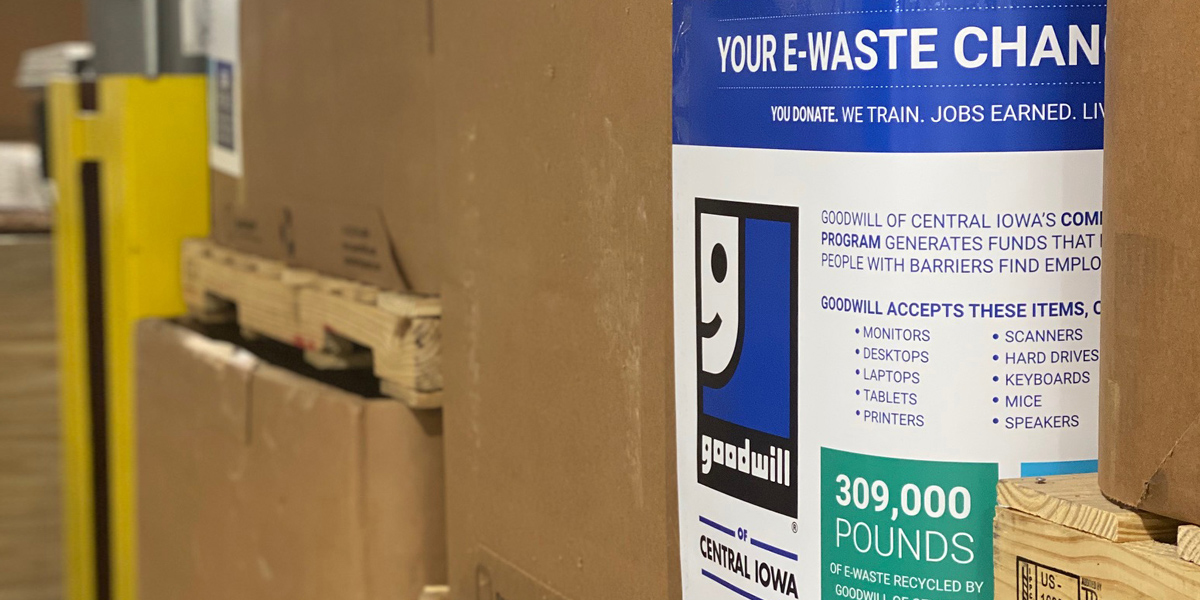Second-Chance Opportunities for Electronics as Consumption Trends Change

Business Record Staff Feb 28, 2020 | 6:13 am
2 min read time
584 wordsBusiness Insights Blog, Training & DevelopmentBY CARLY FLAWS, Director of Marketing, Goodwill of Central Iowa
The electronic revolution has changed the way we live, communicate and connect with people around the world. We live in a technology-obsessed era, upgrading our gadgets almost as often as we upgrade our clothes. All those electronics have to go somewhere, though. Where do they end up and what price are we paying to stay up-to-date with the latest technology trends?
“E-Waste” Explained
What is considered electronic waste, otherwise known as e-waste? The answer is actually pretty simple. E-waste can be defined as any electronic or electronic equipment that is no longer wanted or is now obsolete, whether or not it’s still working. Televisions, computers, laptops, monitors, cell phones, printers, hard drives, keyboards, speakers, ink and toner cartridges, and printers are all examples of items classified as e-waste that often end up in local landfills.
Consumption Trends
Americans produce more e-waste annually than any other country, throwing away over 9.4 million tons of electronics each year. There are more mobile phones in existence than there are number of people living on Earth and the growth rate of mobile devices compared to the population growth rate is five times greater, according to earth911.org.
Over 300 million computers and mobile devices go into production each year. This trend is expected to grow by 8% annually.
With electronics so widely available and the growing demand to constantly upgrade, there’s an urgent need to educate society on how to dispose of unused technology.
Electronics in our landfills
According to the EPA, only 12.5% of e-waste is actually recycled, with the rest dumped into local landfills. Most e-waste that is sent to landfills gets burned, which releases harmful toxins into the air. E-waste comprises 70% of our overall toxic waste, according to theworldcounts.com.
Electronics contain a large concentration of lead, which can damage our central nervous system and kidneys. In addition, even low exposures to lead can impact a child’s mental development.
E-waste contains hundreds of additional toxic substances that make their way into our air and drinking water after being disposed of, including mercury, arsenic, cadmium, selenium, chromium, and flame retardants.
How to recycle e-waste
Goodwill of Central Iowa is the largest recycling partner in the region, with a rapidly evolving electronics recycling program for businesses and individuals. Last year, Goodwill of Central Iowa kept over 300,000 pounds of e-waste out of local landfills by refurbishing and responsibly recycling unused electronics. Goodwill of Central Iowa has been recycling electronics for over 10 years and is an expert in the e-waste recycling space.
Electronics and technology equipment with no useful life left gets recycled through one of Goodwill’s audited and certified recycling channels. Electronics that stand a second chance at life are refurbished by Goodwill technicians and offered for purchase to consumers through Goodwill’s online e-commerce platform, shopgoodwill.com/desmoines. This helps to generate funds that are used to support Goodwill’s job training programs for people facing barriers to employment.
E-waste donations can be dropped off at any Goodwill of Central Iowa retail store (excluding the outlet) and companies can partner with Goodwill for on-site pickup opportunities.
As electronic use grows and technology continues to be mass produced at alarming rates, it’s increasingly critical that consumers dispose of e-waste properly and through responsible recycling channels. Reach out to Goodwill to help identify the best way to recycle your old technology and make the pledge to keep electronic waste as far away from landfills as possible.
 |
Carly Flaws |











